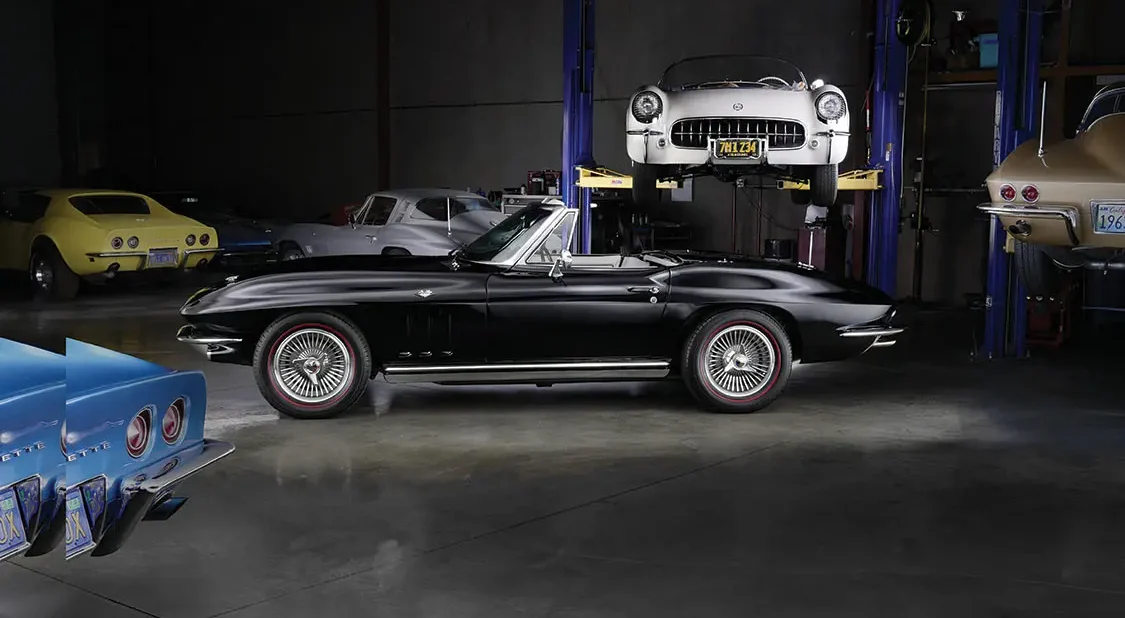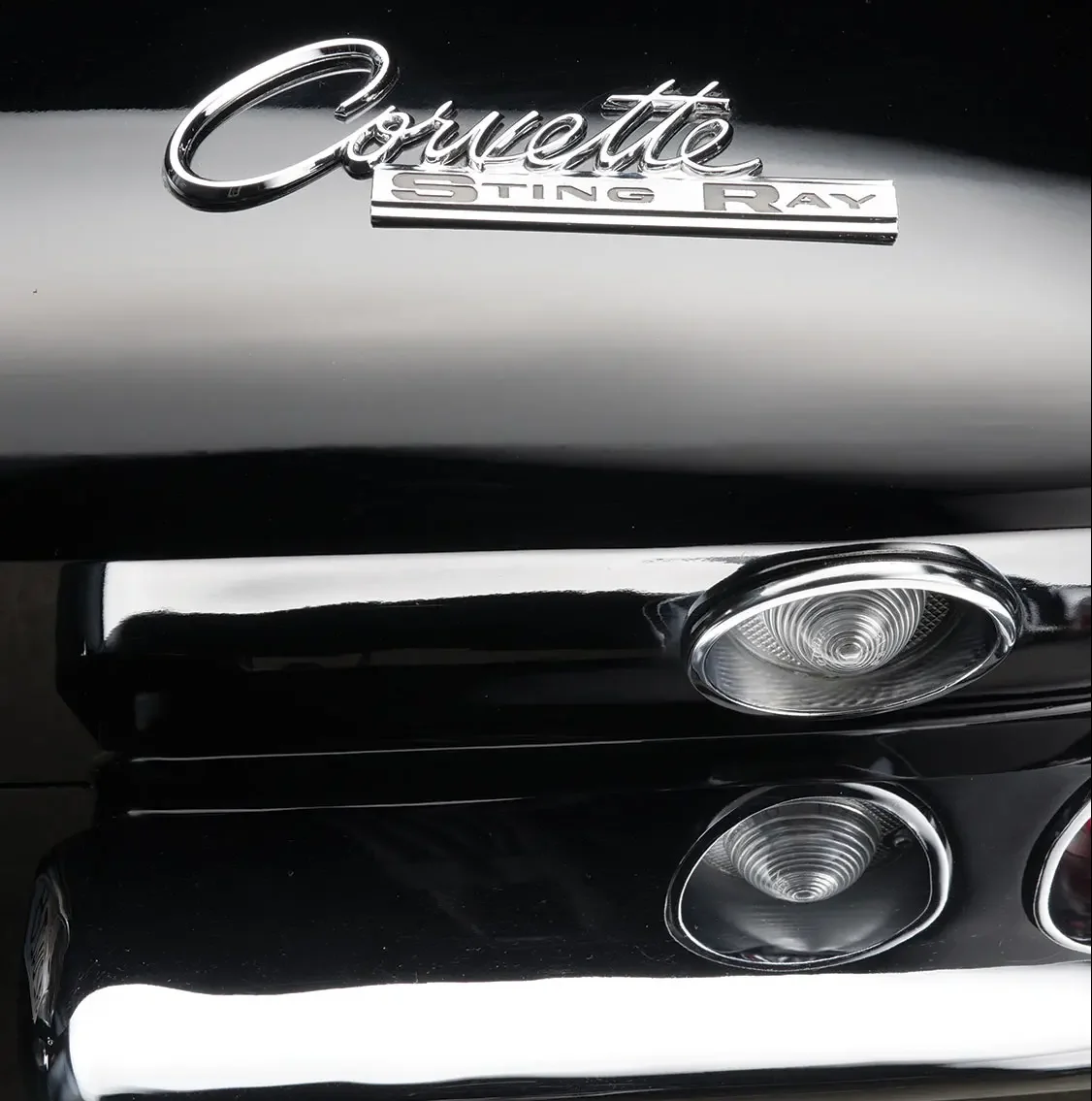 ALAN GALBRAITH
.
March 13, 2023
.
All Feature Vehicles
ALAN GALBRAITH
.
March 13, 2023
.
All Feature Vehicles

It’s difficult to imagine now but in the late 1950s, the Corvette was in trouble. Brought to market in 1953, the early Corvettes suffered from quality control issues and lackluster performance. To save development costs, the Corvette chassis was based on the 1949–1954 Chevrolet passenger vehicle platform and parts. Not the sportiest of underpinnings for what was supposed to be a sports car. The redesigned bodies introduced in 1956 and then again in 1958—along with the addition of a V-8 engine option in 1955—saw increased sales, but the competing Ford Thunderbird still outsold the Corvette 3-to-1. The Corvette was headed for extinction.
The engineering great Zara Arkus-Duntov oversaw the race-car development and it proved to be fast, breaking lap records at Sebring. Mitchell recruited some freshly hired designers to work on the clandestine project and tasked them with penning the next generation of the Corvette. Unbeknownst to the young designers, their careers and Mitchell’s hung in the balance as the design project and Mitchell’s privately funded “Sting Ray” race car were well outside the lines of corporate GM policy. Away from the prying eyes of the other GM executives, the designs ran wild. Mitchell had recently visited Italy and came away impressed with the aerodynamic styling of the Italian design houses. Alfa Romeo’s space-age Disco Volante, which translates to “Flying Saucer,” was one of Mitchell’s favorites. With the Disco Volante as a starting point, the designers set to work and came up with what is arguably one of the most iconic sports-car designs ever. Mitchell presented the new-generation Corvette project to top GM management and they bought in. Completely redesigned aesthetically and based on a proven race-car chassis, the second-generation (C2) 1963 Corvette Sting Ray was born.

Bill Mitchell’s dedication to the Corvette paid off as the 1963 Corvette Sting Ray sales jumped 50 percent from the previous year’s offering. The new look, improved chassis, and genuine sports-car performance won praises from the automotive press. The lighter, shorter wheelbase Sting Ray retained the previous-generation drivetrain options. GM’s venerable carbureted 327 V-8 came in stand-ard 250-hp trim and optional 300-hp and 340-hp versions. A range-topping 360-hp fuel-injected version was available for an extra $430.30. Automatic 3- and 4-speed manual transmissions were available with over 80 percent of new owners opting for the sportiest 4-speed option. At the end of the drivetrain lay one of the second-generation Corvette’s biggest innovations: an independent rear suspension that was available in six gear ratios from 3.08:1 to 4.56:1. Power drum brakes became an option but were only ordered by 15 percent of buyers. The central part of the chassis had nearly twice as much supporting steel as the previous-generation Corvette, yet the new car weighted slightly less due in large part to thinner fiberglass body panels.
The new body featured a distinctive “boattail” treatment to the rear of the passenger compartment. Flip-up headlights blended into the distinct body style line and flairs on the top of the fenders accentuated the tire locations. A coupe and convertible version were offered, the latter with an available liftoff hardtop option. Sales of coupe and convertible models were nearly split evenly at 10,594 and 10,919, respectively.
The C2 Corvette Sting Ray remained largely unchanged for the 1964 model year, save for minor styling changes and some suspension upgrades. The most noticeable of the styling changes was the elimination of the coupe’s split rear window after owners complained of the center bar limiting rearward visibility. New progressive rate springs were used in the front suspension and the rear transverse leaf springs were softened slightly for a more comfortable ride. Engine options remained variations on the 327-cu.-in. small-block, with the addition of a solid lifter, aggressive cam, and Holley 4-barrel carburetor option that was good for 365 hp. Sales again increased, with convertibles outselling coupes 13,925 to 8,304.
Visually, only a trio of working vertical exhaust vents just behind the front wheel, a smoothed hood and different hubcaps separate the 1965 Corvette Sting Ray from the previous model year, however, big things were different under the hood. A big-block engine option became available for the first time in mid-1965. The 396-cu.-in. the engine was called the “Turbo-Jet V8” and cost $292.70 more than the standard 250-hp 327-cu.-in. engine. As offered in the Corvette with a 4-barrel carburetor, GM claimed the 396 produced 425 hp, although it was the fashion of the day to understate the real horsepower output.
The big-block engine was based on knowledge Chevrolet had gained racing stock cars and featured widely angled valve placement in the heads earning it the “porcupine” nickname from the automotive press. The Turbo-Jet V8 sported 11.0:1 compression, impact-extruded alloy pistons, and solid lifters, and required a special hood with a “power blister” to clear the taller engine. A total of 2157 1965 Corvette Sting Ray buyers checked the Turbo-Jet V8 option box in 1965. Four-wheel disc brakes became standard for the 1965 Corvette, although one could still order drum brakes and receive a $64.50 credit off the base price. Only 316 buyers chose the disc brake delete making it one of the least popular options for the 1965 model year. Reviews of the new 4-piston, 2-piece caliper binders compared them favorably to units found in much more expensive Ferraris and Aston Martins. Sales increased yet again over the previous model year and became more heavily weighted in favor of the convertible. Just 8186 coupes versus 15,376 convertible 1965 Corvette Sting Rays rolled off showroom floors.
The 1966 Corvette was largely unchanged as it was supposed to be the last of the C2 generation. Work on the C3 generation was well underway behind the scenes and the new model was expected to become available to the public as a 1967 model. The Turbo-Jet V8 big-block option got even bigger in 1966, displacing 427 cu. in. and coming in two underrated horsepower tunes. With 10.25:1 compression, GM claimed the new displacement engine made 390 hp while the 11:1 compression ratio option was stated to output 425 hp. Ordering the 390-hp big-block would have cost you $181.20 over the base engine, while $312.85 got you the 425-hp version. The high-horsepower, high-torque big-blocks were such a hit with buyers that the small-block options were reduced to only two, the now base 300 hp and higher compression ratio 350-hp versions. Only 10,644 of the 27,720 1966 Corvette Sting Rays sold left the showroom floor with a Turbo-Jet V8 big-block. The convertible again outsold the coupe nearly 2-to-1.
The 1967 Corvette was supposed to introduce an entirely new generation of the American sports car, however, problems with the new design delayed its release so the C2 platform soldiered on for one last year. The big-block options grew to include a “Tri-Power” package of a trio of 2-barrel carburetors and a radical 12.5:1 compression ratio 4-barrel version called the L88. Officially, the L88 produced less horsepower than the Tri-Power big-block and it cost significantly more. The 435-hp Tri-Power 427-cu.-in. engine cost $437.10 more than the base small-block, while the radically underrated 430-hp L88 big-block added $947.90 to the base price that started in the $4000 range. Modern estimates rate the L88 engine at about 560 hp off the showroom floor. Only 20 buyers saw through the ruse intended to confuse insurance adjusters and ordered the L88 option in 1967. With a new generation coming the following year and the C2 design getting long in the tooth, sales of the 1967 Corvette dipped from previous years with the convertible still outselling the coupe 14,436 to 8,504.
When it hit showroom floors in 1963, the all-new Corvette Sting Ray looked and performed like no other American car. The Sting Ray rivaled its European competition in style, finish and handling. By the end of its lifespan in 1967, no other sports car could match the C2 for sheer power output. The second-generation Corvette endures today as a tribute to the dedication of a few GM executives, designers, and engineers. Those men saved the Corvette from extinction and paved the way to its current status as the legendary American sports car.
We use cookies to enhance your browsing experience, serve personalized ads or content, and analyze our traffic. By clicking "Accept All", you consent to our use of cookies. Visit our Cookie Policy for more info.
Notifications
Share Link